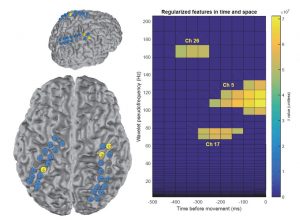Peer-reviewed paper at IEEE Engineering in Medicine & Biology Annual Conference:
Can we estimate upper-extremity force production from electrocorticographic recordings?
 Abstract: Neural correlates of movement planning onset and direction may be present in human electrocorticography in the signal dynamics of both motor and non-motor cortical regions. We use a three-stage model of jPCA reduced-rank hidden Markov model (jPCA-RR-HMM), regularized shrunken-centroid discriminant analysis (RDA), and LASSO regression to extract direction-sensitive planning information and movement onset in an upper-limb 3D isometric force task in a human subject. This mode achieves a relatively high true positive force-onset prediction rate of 60% within 250ms, and an above-chance 36% accuracy (17% chance) in predicting one of six planned 3D directions of isometric force using pre-movement signals. We also find direction-distinguishing information up to 400ms before force onset in the pre-movement signals, captured by electrodes placed over the limb-ipsilateral dorsal premotor regions. This approach can contribute to more accurate decoding of higher-level movement goals, at earlier timescales, and inform sensor placement. Our results also contribute to further understanding of the spatiotemporal features of human motor planning.
Abstract: Neural correlates of movement planning onset and direction may be present in human electrocorticography in the signal dynamics of both motor and non-motor cortical regions. We use a three-stage model of jPCA reduced-rank hidden Markov model (jPCA-RR-HMM), regularized shrunken-centroid discriminant analysis (RDA), and LASSO regression to extract direction-sensitive planning information and movement onset in an upper-limb 3D isometric force task in a human subject. This mode achieves a relatively high true positive force-onset prediction rate of 60% within 250ms, and an above-chance 36% accuracy (17% chance) in predicting one of six planned 3D directions of isometric force using pre-movement signals. We also find direction-distinguishing information up to 400ms before force onset in the pre-movement signals, captured by electrodes placed over the limb-ipsilateral dorsal premotor regions. This approach can contribute to more accurate decoding of higher-level movement goals, at earlier timescales, and inform sensor placement. Our results also contribute to further understanding of the spatiotemporal features of human motor planning.
